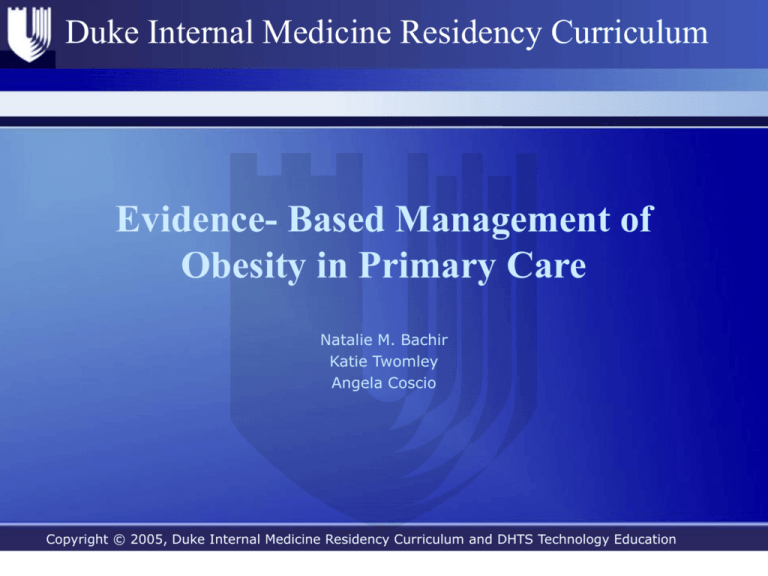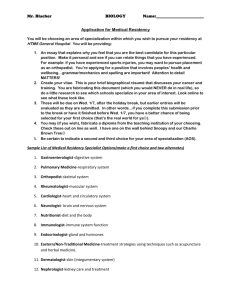Evidence- Based Management of Obesity in Primary Care
advertisement

Duke Internal Medicine Residency Curriculum Evidence- Based Management of Obesity in Primary Care Natalie M. Bachir Katie Twomley Angela Coscio Copyright © 2005, Duke Internal Medicine Residency Curriculum and DHTS Technology Education Duke Internal Medicine Residency Curriculum Learning Objectives • Identify the obese patient • PCP and patient should be clear that obesity is to be managed as a chronic disease • Learn national guidelines on obesity therapy • Identify 3 serious medical problems associated with obesity • Advise patients on resources for smart dieting and refer to nutritionist for help • Know when to think about referring for surgery • Know the limitations of pharmacotherapy • Remember to think about referring to a psychologist Copyright © 2005, Duke Internal Medicine Residency Curriculum and DHTS Technology Education Services Duke Internal Medicine Residency Curriculum Epidemiology of Obesity • Rapidly growing epidemic – In 2000, 64% of adults overweight, 30% obese – Highest prevalence in minorities and poor – Linear increase in obesity with decrease in income among women – Inverse relationship of education (y) and obesity – Hispanic 70% > Black 65% > White 55% • In 2003, 4 states have obesity rates >25%, 31 states between 20-25%, and only 15 states have rates 15-20% • No state has an obesity rate below 15% of the population Copyright © 2005, Duke Internal Medicine Residency Curriculum and DHTS Technology Education Services CDC.gov Duke Internal Medicine Residency Curriculum Epidemiology — Prevalence 2003 Copyright © 2005, Duke Internal Medicine Residency Curriculum and DHTS Technology Education Services Duke Internal Medicine Residency Curriculum Copyright © 2005, Duke Internal Medicine Residency Curriculum and DHTS Technology Education Services Duke Internal Medicine Residency Curriculum Pathogenesis — Genetic • No genes have been identified as contributing to common obesity in humans • Metabolic predictors of obesity: low metabolic rate, increased carbohydrate oxidation, insulin resistance, low sympathetic activity • Under study are the beta-3 adrenergic receptor gene which modifies basal energy expenditure and blood pressure, the ghrelin hormone involved in hunger, cholecytokinin/enterstatin involved in satiety • Leptin gene related hyperphagia and insulin resistance has only been identified in 2 consanguineous families • Obese persons do not have lower resting energy expenditure (BMR) or metabolic responses to caloric intake • Obese persons underestimate their caloric intake and overestimate their energy expenditure compared to normal wt Copyright © 2005, Duke Internal Medicine Residency Curriculum and DHTS Technology Education Services Image: http://www.fewings.ca/polcan/040617Obesity.html Bray, GA. Uptodate “Pathogenesis of Obesity” Duke Internal Medicine Residency Curriculum Pathogenesis — Environmental • Obesity results from energy intake exceeding energy expenditure • Environmental predictors of obesity in the US: socioeconomic status, ethnicity, education level, smoking status -The US as a fat friendly environment • Cultural/societal influence – US prevalence of obesity greater than other western nations • Length of residence in US predicts increasing obesity prevalence for hispanic immigrants – 10% at 0-4 y after immigration to 25% at >15 y • Risk of obesity in adulthood increases with obesity in childhood, especially obesity extending into adolescence • Risk that a child will grow up to be an obese adult increases with each parent that is obese Kaplan,M Am J Prev Med 2004;27(4)323 Bray, GA. Uptodate “Pathogenesis of Obesity” Copyright © 2005, Duke Internal Medicine Residency Curriculum and DHTS Technology Education Services Duke Internal Medicine Residency Curriculum Morbidity of Obesity — Endocrine • Metabolic Syndrome – Prevalence of metabolic syndrome in the US approximately 30% – Majority of metabolic syndrome is attributed to obesity – Defined as 3 of 5 of the following: waist circumference > 35 in for women, 40 in for men; SBP > 135 or DBP > 85 (untreated); TGL > 150; HDL < 50 in women or < 40 in men; FBG > 100 – Increases risk of type 2 DM by 7-10 times – Increases the risk of CVD by 3-5 times • Type 2 Diabetes – Linear increase in risk of DM2 with BMI – Risk of DM2 increases starting with BMI of 22 Copyright © 2005, Duke Internal Medicine Residency Curriculum and DHTS Technology Education Services AGA technical review of obesity Duke Internal Medicine Residency Curriculum Morbidity of Obesity — Cardiovascular • Dyslipidemia – Progressive increase in total cholesterol with increasing BMI in men (NHANES III) • Coronary artery disease – Abdominal circumference independently associated with risk of CVD, regardless of BMI – Obesity recently listed as major risk factor for CHD • Hypertension – Abdominal circumference independently associated with hypertension, regardless of BMI – Greater than 2X prevalence of hypertension among obese • Ischemic stroke – Obese women had twice the number of ischemic strokes than normal wt women in one epi study, a similar study in men showed no statistical difference Copyright © 2005, Duke Internal Medicine Residency Curriculum and DHTS Technology Education Services AGA technical review of obesity Duke Internal Medicine Residency Curriculum Morbidity — Pulmonary and Musculoskeletal • Obstructive sleep apnea – Increased risk of OSA with BMI>30 and neck circumference > 17 inches • Obesity hypoventilation syndrome – Restrictive lung disease secondary to increased weight/pressure on chest wall prohibiting expansion of lungs • Osteoarthritis – Obesity associated with increased prevalence of OA in both weight-bearing and non-weight-bearing joints – Weight loss improves symptoms of OA in the knees • Gout – Obesity associated with hyperuricemia and development of gout Copyright © 2005, Duke Internal Medicine Residency Curriculum and DHTS Technology Education Services AGA technical review of obesity Duke Internal Medicine Residency Curriculum Morbidity — Gastroenterology • GERD – Increased prevalence of reflux symptoms in obese persons, however diet induced wt loss not shown to decrease symptoms • Gallbladder disease – Risk of symptomatic gallstones increases linearly with BMI – Association is more remarkable in women than in men • Pancreatitis – Obesity associated with poor prognosis in pancreatitis • NASH (non-alcoholic steatohepatitis) – Over half of NASH attributable to obesity – 10% of NASH results in cirrhosis • Worsened prognosis in other liver disease (alcoholic and Hep C) Copyright © 2005, Duke Internal Medicine Residency Curriculum and DHTS Technology Education Services AGA technical review of obesity Duke Internal Medicine Residency Curriculum Mortality • Complicated due to use of multiple approximated numbers: prevalence, relative risk, death rate • Estimated to be as low as 112K or as high as >300K depending on the estimates used and controlling for confounders • Risk of obesity-related mortality decreases with relative risk near 1 at age 75 and above • Calculations use prevalence of obesity and not duration of obesity which may affect risk Copyright © 2005, Duke Internal Medicine Residency Curriculum and DHTS Technology Education Services Flegal, K. Am J Public Health. 2004. 94(9): 1486 Duke Internal Medicine Residency Curriculum Obesity in the Primary Care Setting • Most people who lose weight and are dismissed from clinical therapy will frequently regain the weight. – Weight loss as an endpoint is an outdated health goal and now the evidence shows that observation, monitoring, and encouragement of patients who have lost weight should be continued long-term, much like the management of a chronic disease. • In 1998 the NIH released a consensus statement of evidence-based guidelines for management of the obese patient, based on review of 394 RCTs 1/80 - 9/97. • This has been endorsed by other groups such as the American College of Preventive Medicine • In 2003 the USPSTF released a consensus statement of evidence-based guidelines National Institutes of Health’s Expert Panel on the Identification, Evaluation, and Treatment of Overweight and Obesity in Adults Arch Intern Med Sept 1998;158:1855-1867 Am J Prev Med 2001;21(1):73-78. summary of USPSTF evidence, McTigue KM et al. Screening and Copyright © 2005, Duke Internal Medicine Residency CurriculumFor and DHTS Technology Education interventions for obesity in adults: summary of the evidence for the U.S. Services Preventive Services Task Force. Ann Intern Med 2003;139:933. Duke Internal Medicine Residency Curriculum PCP Barriers to Evaluation and Treatment Obesity • Do you, your clinic, or your patient have any of these? Lack of payment by health-insurance and managed-care plans for obesity-related treatment programs Lack of time for dedicated patient education and counseling on weight loss and weight maintenance Lack of recognition of obesity as a chronic condition that is difficult to treat, requires continuous and long-term management, and has high relapse rates Insufficient data on the effectiveness of physician weight loss counseling and skepticism about the success of any medical treatment of obesity Lack of data on the long-term safety and efficacy of pharmacotherapeutic agents for obesity Lack of patient interest or readiness for treatment Negative perceptions that obesity represents a lack of patient discipline, self-control or will power rather than a chronic disease Inadequate training in the medical management of obesity Copyright © 2005, Duke Internal Medicine Residency Curriculum and DHTS Technology Education Services Adapted from Table 7 in American Family Physician June 1, 2001;63(11):2185-2196 Duke Internal Medicine Residency Curriculum Obesity Management in Primary Care The Role of the PCP • • • • Setting reasonable weight loss goals, selecting appropriate weight loss programs, referring patients to ancillary personnel, providing monitoring, support, encouragement. Set an example by considering your own weight. Understanding of causes of obesity and how obesity contributes to disease Heighten the patient’s motivation for weight loss, prepare patient for treatment Enumerate dangers which come with obesity Describe strategy for clinically assisted weight loss. If the patient has had previous unsuccessful attempts, describe how the new plan will be different Obesity is a chronic disease; the weight maintenance program will be life-long American Family Physician June 1, 2001;63(11):2185-2196 Copyright © 2005, Duke Internal Medicine Residency Curriculum and DHTS Technology Education Arch Intern Med Sept 1998;158:1855-1867 Services Duke Internal Medicine Residency Curriculum Assessment — Degree of Overweight NIH Approach: 2-Step Guideline of assessment and treatment Accurate methods to assess total body fat include unavailable expensive measures such as total body water, total body potassium, bioelectrical impedance, dual-energy X-ray absorptiometry however there is no trial data to indicate the best method. Similarly, to assess abdominal fat content, MRI and CT are the most accurate but not practical. Nonrandomized studies and clinical experience show that BMI is significantly correlated with total body fat content. = Kg/m2 or [lbs/in2]x703. BMI correlates with morbidity and mortality. Go to http://www.nhlbisupport.com/bmi/ for BMI calculator. Waist Circumference correlates with abdominal fat content. The presence of excess fat in the abdomen is an independent predictor of risk factors and morbidity, and is associated with increased risk for type 2 DM, dyslipidemia, HTN, CVD. Copyright © 2005, Duke Internal Medicine Residency Curriculum and DHTS Technology Education Services Arch Intern Med Sept 1998;158:1855-1867 Duke Internal Medicine Residency Curriculum Assessment — Degree of Overweight This chart indicates disease relative risk, relative to normal weight and waist circumference. This will determine the need to institute weight loss therapy in your patient. Class BMI (kg/m2) Men 102 cm, women 88 cm Men >102 cm, women >88 cm Normal 18.5 - 24.9 … … Overweight 25-29.9 Increased High Obesity Class I 30-34.9 High Very High Obesity Class II 35-39.9 Very High Very High Obesity Class III 40 Extremely High Extremely High Copyright © 2005, Duke Internal Medicine Residency Curriculum and DHTS Technology Education Services Arch Intern Med Sept 1998;158:1855-1867 Duke Internal Medicine Residency Curriculum Assessment — Risk Status Now to determine absolute risk, which is a summation of risk factors. The following indicates increased risk for disease complications and mortality, which again stresses the need for weight loss reduction. – Disease conditions. • CAD, other atherosclerotic diseases, type 2 diabetes, sleep apnea • Gynecological abnormalities, OA, gallstones/GB complications, stress incontinence – Other risk factors. • Physical inactivity, TGs >200mg/dL • Cardiovascular risk factors. Cigarettes, HTN, LDL>160, HDL<35, fasting glucose>110-125, family hx, age – Remember to use the ATP III and JNC VII guidelines in assessment and treatment of cholesterol and blood pressure Copyright © 2005, Duke Internal Medicine Residency Curriculum and DHTS Technology Education Services Arch Intern Med Sept 1998;158:1855-1867 Duke Internal Medicine Residency Curriculum Assessment — Patient Motivation The patient needs to be ready to lose weight Reasons and motivation for weight reduction History of successful/unsuccessful weight loss attempts Support of family, friends, worksite Attitude towards physical activity, capacity to engage in physical activity Time available for weight loss intervention, Financial considerations Copyright © 2005, Duke Internal Medicine Residency Curriculum and DHTS Technology Education Services Arch Intern Med Sept 1998;158:1855-1867 Duke Internal Medicine Residency Curriculum Copyright © 2005, Duke Internal Medicine Residency Curriculum and DHTS Technology Education Services Duke Internal Medicine Residency Curriculum Assessment — Patient Motivation Patients need to understand that losing weight is as medically necessary as their prescription medications, and losing weight, if done correctly, comes without side effects. There has been a recent urging in all fields that counseling patients in lifestyle changes should be given as much weight as knowing which medication to prescribe when -- for example, at recent meetings for the American Society for Hypertension and American College of Sports Medicine. http://www.surgeongeneral.gov/topics/obesity/calltoaction/1_2.htm “Many Overweight Arthritis Patients Aren’t Told to Lose Weight, Exercise” and “Urge Hyptertensives to Change Habits,” Internal Medicine News Aug 1 2005;38(15) p.9 and p.55 Copyright © 2005, Duke Internal Medicine Residency Curriculum and DHTS Technology Education Services Image: http://www.medicineau.net.au/clinical/obesity/obesit1209.html Duke Internal Medicine Residency Curriculum Treatment Management — Weight Loss Goals The initial goal is to reduce body weight by 10% from baseline in 6 months ;after this, further weight loss can be attempted. Remember, the cornerstone of obesity therapy is to eat fewer calories than are expended in order that endogenous fat stores will be consumed as fuel. BMI (kg/m2) 25-29.9 30-34.9 35-39.9 40 Class Overweight* Class I Class II Class III Energy Deficit (kcal/d) 500 500 500-1000 500-1000 Weight loss per week (lb;kg) 1; 0.45 1; 0.45 1-2; 0.45-0.90 1-2; 0.45-0.90 *Weight loss recommendations in this group apply if the patient also has 2 or more cardiovascular risk factors. AGA technical review on obesity. Gastroenterology 2002; 123:882. Arch Intern Med Sept 1998;158:1855-1867 Copyright © 2005, Duke Internal Medicine Residency Curriculum and DHTS Technology Education Services Duke Internal Medicine Residency Curriculum Treatment Management — Strategy • After a 10% weight loss reduction at 6 months, if more weight loss is needed, additional attempt at weight reduction. Or, a weight maintenance program becomes a priority. • If patients are unable to achieve weight loss, either a new strategy needs to be pursued, or prevention of further weight gain becomes a new goal. • Strategy for Weight Loss and Weight Maintenance: – – – – – Dietary Therapy. Physical Activity Behavior Therapy Pharmacotherapy for BMI >30 or >27 w/comorbidities 22 RCTs contain strong evidence that multimodal strategies for weight loss work best • Surgery for BMI>40 or BMI>35 w/comorbidities when medical efforts have failed at 6 and 12 month checks Arch Intern Med Sept 1998;158:1855-1867 USPSTF Guidelines: Screening for obesity in adults: Recommendations and rationale (www.guideline.gov) Copyright © 2005, Duke Internal Medicine Residency Curriculum and DHTS Technology Education Services Duke Internal Medicine Residency Curriculum Which diet to recommend? 48 RCTs reviewed by the expert panel: controlled energy/low calorie, very controlled energy/very low calorie, vegetarian, AHA, NCEP’s Step I w/energy intake restriction, other low-fat regimen Recommendations: Controlled energy diet with fat reduction • c/w NCEP Step I or Step II – 500-1000 kcal/d energy deficit – Total fat 30% or less of total energy – Reduce saturated fat to reduce LDL-C Refer patients to AHA website and nutritionist for complete diet plan AHA Dietary Guidelines: revision 2000: a statement for healthcare professionals • from the Nutrition Committee of the American Heart Association. Circulation. 2000;102:2284-2299. American Institute for Cancer Research. Food, Nutrition and the Prevention of Cancer: A Global Perspective. Washington, DC: World Cancer Research Fund/American Institute for Cancer Research; 1997. Executive Summary of the Third Report of the National Cholesterol Education Program Expert Panel on Detection, Evaluation, and Treatment of High Blood Pressure (ATP III) JAMA. 2001;285:2486-2497. Curriculum DHTS Technology Education Lowe MR etand al. Obes Res. 1999;7:51-59. Weight watchers in based in sound medical dietary advice Copyright © 2005, Duke Internal Medicine Residency Services Image: http://www.mydietrecipes.com/diet-recipes/testimonies/diet/testimonies.php Duke Internal Medicine Residency Curriculum The High-Protein, High-Fat, Low-Carbohydrate Diet • The premise is that a metabolic ketosis is induced resulting in quick weight loss. How? – Most weight loss occurs in the first few weeks – Diuretic effect due to -- very low carbohydrate intake which influences sodium and water loss, glycogen depletion, and ketosis – Loss of appetite is associated with ketosis – If 30% kcal from protein, negative energy balance due to restriction in type/amount foods eaten – Efficacy and safety long term still not yet proven. A popular premise of these diets is that excess carbohydrates results in elevated insulin, which promotes storage of body fat. However, protein intake also stimulates insulin secretion. Copyright © 2005, Duke Internal Medicine Residency Curriculum and DHTS Technology Education Services Circulation. 2001;104:1869-1874. Duke Internal Medicine Residency Curriculum The Data on Low-Carb, High-fat, High-Protein Diets • Conflicting data regarding weight loss and influence on cardiac risk factors in comparison to low-fat diet – Some trials show difference in weight loss, some don’t – Some trials show the high protein diet will increase HDL, decrease TGs but increase LDL, which is of unclear benefit – Low-carb diet is supplemented w/MVI, fish oil which may have effect • Sustained ADHERENCE to diet, rather than diet TYPE, found to dictate weight loss and CV risk reduction – Some trials show low-carb diet less sustainable, some show low-fat diet less sustainable. One trial showed Weight Watchers had best adherence • Trial problems: diets used are not all uniform, primary outcomes are reported as absolute amount rather than percentage of weight lost, longest trial to date has a follow-up JAMA, Jan 5 2005;293(1) of one year. Ann Intern Med 2004;140:769-777 N Engl J Med 2003;348:2074-2081. N Engl J Med 2003;348:2082-2090 J Clin Endocrinol Metab. 2003;88:1617-1623 Copyright © 2005, Duke Internal Medicine Residency Curriculum and DHTS Technology Education Ann Intern Med 2004;140(10):778-785 Services Duke Internal Medicine Residency Curriculum Calories Here are the number of calories women and men need each day. The obese person gets far more than these each day, due to overeating in combination with a sedentary lifestyle. Age 19-30 31-50 51+ Women 2000 1800 1600 Men 2400-3000 2200 2000 Taken from: http://www.wegmans.com/eatwelllivewell/weightManagement/020105.a sp Copyright © 2005, Duke Internal Medicine Residency Curriculum and DHTS Technology Education Services Duke Internal Medicine Residency Curriculum The Medically Sound Diet • For the protein diet: – Total protein intake should not be excessive and be proportional to carbohydrate and fat intake – Carbohydrates should not be omitted or severely restricted – Protein foods should not contribute excess total fat, saturated fat, or cholesterol – Should be safe long term by providing adequate nutrients and comply with guidelines to prevent increase in disease risk. – Protein 50-100g/day, 15% of kcal/day – Carbohydrate at least 100g/day, 55% of kcal/day – Fat 30% of kcal/day Copyright © 2005, Duke Internal Medicine Residency Curriculum and DHTS Technology Education Services American Family Physician June 1, 2001;63(11):2185-2196 Circulation. 2001;104:1869-1874. Duke Internal Medicine Residency Curriculum • Potential Complications of Weight Loss: – – – – – Excessive loss of lean body mass Dehydration Electrolyte imbalance Gallbladder disease Psychological distress due to conflicts w/loved ones, etc Copyright © 2005, Duke Internal Medicine Residency Curriculum and DHTS Technology Education Services Duke Internal Medicine Residency Curriculum Physical Activity – Prevention of weight regain, moderately contributes to weight loss, increases cardiorespiratory fitness – Reduction of CAD and DM risk beyond that of weight loss alone Recommendations based on review of 13 RCTs: – Reduce sedentary time – Walking or swimming at a slow pace – Walk 30 min/day for 3 days/week, building up to 45 minutes of more intense walking, 5 days a week – This will add an expenditure of 100-200kcal/day Copyright © 2005, Duke Internal Medicine Residency Curriculum and DHTS Technology Education Services Arch Intern Med Sept 1998;158:1855-1867 Duke Internal Medicine Residency Curriculum Behavior Therapy • Evidence that high-intensity counseling together with behavioral interventions produces a modest, sustained weight loss • High-intensity counseling = more than 1 person-to-person (individual or group) session per month for at least the first 3 months • Includes self-monitoring of eating habits and physical activity, stress management, stimulus control, problem solving, contingency management, cognitive restructuring, social support; skill development, motivation, and support strategies • Refer obese patients to programs of intensive counseling and behavioral interventions. Concerted effort by physicians, psychologists, dieticians, behavioral therapists, exercise physiologists, nurses, multidisciplinary teams USPSTF Guidelines: Screening for obesity in adults: Recommendations and rationale (www.guideline.gov) American Family Physician June 1, Copyright © 2005, Duke Internal Medicine Residency Curriculum and DHTS Technology Education 2001;63(11):2185-2196 Services Duke Internal Medicine Residency Curriculum Pharmacotherapy • If 6 months of combined dietary, behavioral and physical therapy are unsuccessful, pharmacologic therapy should be considered: • Approved agents – Sibutramine – Orlistat • Agents approved for indications other than weight loss • Herbal or OTC agents • Agents still under investigation Copyright © 2005, Duke Internal Medicine Residency Curriculum and DHTS Technology Education Services Duke Internal Medicine Residency Curriculum Pharmacologic therapy Sibutramine - Decreases appetite and increases metabolic rate – Meta-analysis data shows a 4.5kg wt loss at one year compared to placebo – Side effects: modest increase in HR and BP, insomnia Phentermine – Meta-analysis: mean wt loss of 3.6kg – Contraindications - symptomatic CAD, hyperthyroidism, HTN, glaucoma Diethylpropion – Meta-analysis: mean wt loss of 3.0kg; borderline statistical significance Arch Intern Med 2004;164:994-1003 Lancet 352:167-172 Ann Intern Med 2005;142:532-46. Copyright © 2005, Duke Internal Medicine Residency Curriculum and DHTS Technology Education Services Eur J Clin Pharmacol 46:405-10. Duke Internal Medicine Residency Curriculum Orlistat • Lipase inhibitor – dose related increase in fecal fat starts at dose of 200mg/day and plateaus at 400-600mg/day • Meta-analysis data shows 2.59kg loss at 6 mo and 2.89kg at 12 mo • Two year studies show 52% of lost wt regained if drug stopped, 32% of lost wt regained if drug continued • Adverse effects – flatus, abdominal cramping, fecal incontinence, oily spotting, potential for malabsorption of fat soluble nutrients • Beneficial lipid effects: • Lowers total cholesterol 7% compared to placebo • Lowers LDL 5% compared to placebo Copyright © 2005, Duke Internal Medicine Residency Curriculum and DHTS Technology Education Services Duke Internal Medicine Residency Curriculum Off Label Pharmacologic Therapy • Fluoxetine (9 studies) – higher dose than depression: 60mg rather than 20mg – 4.74kg at 6 months, 3.15kg at 12 months • Topiramate (6 studies, only one published) – No recommendations due to limited data • Sertraline (1 study) – Small study without statistically significant results • Buproprion (3 studies) – 2.77kg at 6 to 12 months • Metformin – increases insulin sensitivity, decreases intestinal absorption of glucose, and decreases hepatic glucose production – 1996 RCT of 324 patients with upper body obesity showed 2kg wt loss in 1yr on metformin compared to 0.8kg weight gain on placebo Copyright © 2005, Duke Internal Medicine Residency Curriculum and DHTS Technology Education Le Z et al. Meta-analysis: pharmacologic treatment of obesity. Ann Intern Med. 2005; 142: 532-46. Services Diabetes Care. 1996;19:920-926. Duke Internal Medicine Residency Curriculum Other Pharmacologic Options • Herbal and OTC. There is no evidence regarding safety or efficacy of any of these agents: Ephedrine 5-hydroxytryptophan Pyruvate Aloe Dandelion Guar Gum Agents under investigation: • Cannabinoid antagonists • B-3 adrenergic agonists • Ghrelin, cholecystokinin A agonists, Human Growth Hormone peptide analogs, leptin Website address: www.hateweight.com Copyright © 2005, Duke Internal Medicine Residency Curriculum and DHTS Technology Education Services Duke Internal Medicine Residency Curriculum Rimonabant (Acomplia) • Cannabinoid-1 receptor blocker • Decreases diet induced obesity and hyperlipidemia • Under production by Sanofi-Aventis;Currently in phase III of development, expected to be on the market by early 2006 • RIO-Europe Study • RIO-North America, RIO-lipids, ROI-diabetes and pooled data not yet published; presentation available on Aventis website with unpublished data: --> http://en.sanofiaventis.com/Images/44_25259.pdf Copyright © 2005, Duke Internal Medicine Residency Curriculum and DHTS Technology Education Services Lancet 2005 April 16-22; 365(9468): 1389-97. Duke Internal Medicine Residency Curriculum Surgical Options Roux-en-Y gastric bypass (RTGB) Limits gastric capacity and causes mild malabsorption Biliopancreatic bypass www.bariatricinstituteky.com/ procedure.html Limited gastrectomy and long intestinal bypass causes malabsorption http://www.yoursurgery.co m/procedures/bariatric/im ages/biliopancreatic.jpg Laparoscopic adjustable gastric band In other countries, device around uppermost stomach limits capacity Vertical banded gastroplasty http://northern.uhspublications.com/winter2005/i mages/story2pic2.gif Stapling of upper stomach to reduce capacity http://www.bariatricinstituteky.co m/images/stomach-stapling.gif Copyright © 2005, Duke Internal Medicine Residency Curriculum and DHTS Technology Education Services Duke Internal Medicine Residency Curriculum Surgery Outcomes • Weight loss: pooled data from five RCTs show that bypass procedures result in more weight loss than banding procedures • SOS study – evaluations of comorbid conditions including DM, HTN, hyperlipidemia improves with surgery in association with weight loss • Ongoing study of incidence of CVA, MI, and cancer in control v. surgical groups • Mortality: – No statistically significant difference in mortality when comparing various procedures – 30 day and inpatient mortality data of 62,000 procedures in the state of WA from 1987-2001 were reported to be 1.9%. – Inpatient mortality studies in California and Pennsylvania are 0.3% and 0.6% respectively. – Mortality does depend on surgical center and surgical volume. Copyright © 2005, Duke Internal Medicine Residency Curriculum and DHTS Technology Education Services Duke Internal Medicine Residency Curriculum Guidelines - origins, endorsers, position statements National Heart, Lung, and Blood Institute’s Obesity Education Initiative National Institute of Diabetes and Digestive and Kidney Diseases (National Task Force on the Prevention and Treatment of Obesity) National High Blood Pressure Education Program North American Association for the Study of Obesity American Heart Association American Diabetes Association American Academy of Pediatrics American Association of Clinical Endocrinologists/American College of Endocrinology American Obesity Association http://www.obesity.org/ U.S. Clinical Preventive Services Task Force Institute of Medicine World Health Organization - International Obesity Task Force USPSTF American College of Obstetricians and Gynecologists American Dietetic Association http://www.eatright.org American Academy of Family Physicians American Medical Association For “The Clinical Guidelines on the Identification, Evaluation, and Treatment of Overweight and Obesity in Adults: Evidence Report” go to http://www.nhlbi.nih.gov/nhlbi/nhlbi.htm www.preventiveservices.ahrq.gov www.guideline.gov Also…for more information… Healthy People 2010, go to http://www.healthypeople.gov/ The New Food Pyramid – www.MyPyramid.gov http://www.weightwatchers.com Am Fam Physician 2001; 63:2185-96 Copyright © 2005, Duke Internal Medicine Residency Curriculum and DHTS Technology Education Arch Intern Med Sept 1998;158:1855-1867 Services Duke Internal Medicine Residency Curriculum References Lyznicki JM et al. Obesity: assessment and management in primary care. American Family Physician June 1, 2001;63(11):2185-2196 National Institutes of Health’s Expert Panel on the Identification, Evaluation, and Treatment of Overweight and Obesity in Adults, in Arch Intern Med Sept 1998;158:1855-1867 Dansinger ML et al. Comparison of the Atkins, Ornish, Weight Watchers, and Zone Diets for Weight Loss and heart Disease Reduction. JAMA Jan 5 2005;293(1):43-53. Yancy WS Jr et al. A low-carbohydrate, ketogenic diet versus a low-fat diet to treat obesity and hyperlipidemia: a randomized, controlled trial. Ann Intern Med 2004;140:769-777 Samaha FF et al. A low-carbohydrate as compared with a low-fat diet in severe obesity. N Engl J Med 2003;348:2074-2081 Foster GD et al. A randomized trial of a low-carbohydrate diet for obesity. N Engl J Med 2003;348:2082-2090 Brehm BJ et al. A randomized trial comparing a very low carbohydrate diet and a calorie-restricted low fat diet on body weight and cardiovascular risk factors in healthy women. J Clin Endocrinol Metab. 2003;88:1617-1623 Stern L et al. The effects of low-carbohydrate versus conventional weight loss diets in severely obese adults: one-year followup of a randomized trial. Ann Intern Med 2004;140:778-785 Nawaz H and Katz DL. American College of preventive medicine Practice Policy Statement: Weight Management Counseling of Overweight Adults. Am J Prev Med 2001;21(1):73-78. McTigue KM et al. Screening and interventions for obesity in adults: summary of the evidence for the U.S. Preventive Services Task Force. Ann Intern Med 2003;139:933. McTigue KM et al. Screening and interventions for obesity in adults. Systematic Evidence Review No. 21. Rockviille, MD:Agency for Healthcare Research and Quality. December 2003. www.ahrq.gov/clinic/serfiles.htm Copyright © 2005, Duke Internal Medicine Residency Curriculum and DHTS Technology Education Services Duke Internal Medicine Residency Curriculum References Arterburn et al. The efficacy and safety of sibutramine for weight loss: a systematic review. Arch Intern Med 2004;164:994-1003 Fontbonne A et al. The effect of metformin on the metabolic abnormalities associated with upper body fat distribution. BIGPRO Study Group. Diabetes Care 1996; 19(9): 920-926. Luc F Van Gaal, et al. Effects of the cannabinoid-1 receptor blocker rimonabant on weight reduction and cardiovascular risk factors in overweight patients: 1-year experience from the RIO-Europe study. 2005 Lancet; 365(9468): 1389-1397. Copyright © 2005, Duke Internal Medicine Residency Curriculum and DHTS Technology Education Services




